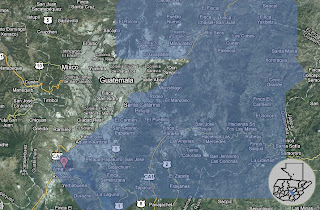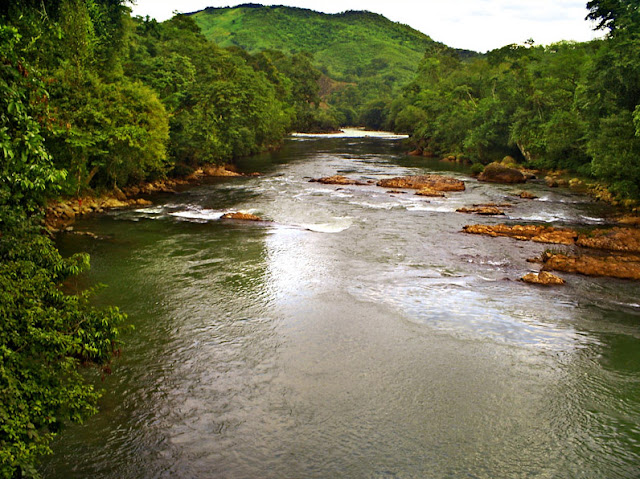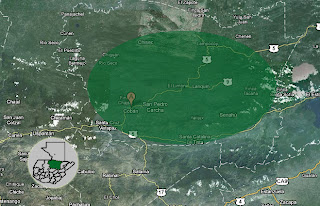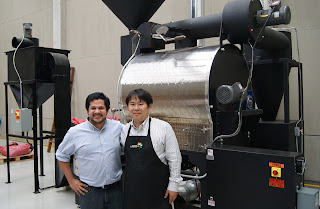Guatemalan Coffee
by Josué Morales.
martes, 15 de mayo de 2012
Visits to the TG LAB
During the 2012 coffee cupping season I received the visit of many coffee frieds in my coffee lab, the TG-LAB in Guatemala City. It is for me a great honor and an amazing learning experience to have been visited by these friends.
jueves, 2 de febrero de 2012
The Mayaland Coffee packaging was featured in www.thedieline.com, the world's No. 1 site for packaging!
http://www.thedieline.com/blog/2012/2/24/mayaland-coffee.html
“Mayaland Coffee set out to become the leading world brand of Guatemalan Coffee. The idea was to create a compelling graphic image that could communicate the essence of Guatemala, a colorful and vibrant country that produces some of the best coffees in the world.
The ancient Mayan heritage was taken as the basis, and the macaw birds were chosen for being remarkable and complex animals that create a striking contrast when flying over our dense forests and in our deep blue skies.
All of our coffees are direct trade and grown at high elevations in the Guatemalan mountains and volcanoes.
Our concept of "Roasted at Origin" was also an essential feature to incorporate as its a new concept in the coffee industry used to define our production system that consists of maintaining close relationships with our farmers throughout the year and roasting the coffee in Guatemala, thus preserving coffee from staling due to long periods of storage, preventing it from suffering extreme altitude, temperature and moisture variations, and roasting them to their full potential at peak moments in their maturity process. The final outcome was Azul and Rojo, which are two sides of a spectrum, one lighter, one darker, always in balance as the forces of nature.
The Mayaland Coffee logo contains the Macaw bird in the center of the Mayan Calendar signifying something that unites this balance with deeper cultural roots. The seven peaks in the logo were chosen as the number of perfection for the Mayan; being seven the symbolic number of completeness as four plus three is the union of day and night, also the union of man and woman.
Seven is its own numeric value and it's also one whole number, Mayans view this number as equivalent to eight thus emanating perfection and infinity."
Created by the founding team of Mayaland Coffee in a long brain storming session early last year and brought into reality designer Renato Barrios.”
“This packaging design is just great, makes Mayaland stand out on the shelf like a parrot in the rainforest!” -Paul Scheeler-
miércoles, 2 de noviembre de 2011
Visiting Groundwork and The Coffee Bean
On november 2011, I had the privilege of visiting friends and fellow roasters in Los Angeles. I was greeted by Jeff Chean at Groundwork Coffee; and by Jesse Martinez at The Coffee Bean and Tea Leaf.
It was a great learning experience!
It was a great learning experience!
 |
| Jesse Martinez from The Coffee Bean & Tea Leaf. Josué Morales. |
 |
| Jeff Chean from Groundwork Coffee and Josué Morales. |
lunes, 28 de febrero de 2011
GUATEMALAN COFFEE REGIONS PROFILE NO. 6: HUEHUETENANGO
Perhaps the most remote and rough areas in Guatemala, this region has proven to constantly deliver great flavor and character in every cup.
By. Josué Morales
By. Josué Morales
 |
| Guatemalan Coffee Profile Huehuetenango. |
 |
| Guatemalan Coffee Regions Huehuetenango. Images by Google. |
Early December, the drive to Huehuetenango feels wearisome and tired. Its a tough terrain to drive through, but worth it. "You must be early at the plantations and prepare to leave by two," is what the local guides recommend. "If you don't leave by 2.00 pm we better prepare you a place to stay, otherwise rain and mist won't let you out of the mountain."
Elevation is felt immediately as one reaches the City of Huehuetenango, which gives the Region and the Department in Guatemala, its name. Its an extremely high range of mountains that get nourished by the warm winds that blow from the vast Tehuantepec Plains in México; allowing for great coffee to be nurtured without frost at these elevated altitudes. Home of one of the main Kingdoms of the Ancient Mayan culture, archeological sites still remain to remind us of the great history and heritage of this place. Silver, lead, zinc. copper and gold may be found and excavated in Huehuetenango, but its real jewel and prized possession is the one found in its magnificent coffee.
Coffee has been produced in this region since the 19th Century, making it a refined process of quality, the one in which coffee is brought up to perfection. Some of the best coffee may be found in the enclosed valleys formed by the mountain ranges. Unique micro-climate variations help coffee to slowly develop into exotic flavors.
 |
| Guatemalan Coffee Regions. Mayan Ruins of Zaculeu in Huehuetenango. Photo by. Josué Morales |
Characterized by being strong and highly aromatic, coffee from this region can be very versatile. Demonstrating high chocolate flavor with pears, apple, and cinnamon complexions that are accompanied by a relatively delicate and smooth lightly syrupy body and a gently charred cedar that, with patience, rounds toward caramel. Clean, rich finish with marked changes as coffee harvested moves away from the Mexican border and into Guatemala.
 |
| Coffee farmer at Finca Huixoc in Huehuetenango. Photo by Josué Morales. |
GUATEMALAN COFFEE REGIONS PROFILE NO. 5: FRAIJANES
It's often a big surprise to find such excellent coffee in the mountains that surround Guatemala City. The Region of Fraijanes is a vast extension of old forests, rough land, and peaceful people.
By. Josué Morales
By. Josué Morales
 |
| View of the drying patio at Finca San Jorge in Palencia. Considered part of the Fraijanes Plateu. Photo by Josué Morales. |
 |
| Guatemalan Coffee Profile: Fraijanes SHB |
Coffee from this region is characterized for being one of the most intense from all of Guatemala. Although this region is so vast that the idea that all the coffee produced here can have a common denomination is a misconception from many points of view. The classification of this region was done so based on the geographical location and the high altitudes of the mountain range that surrounds Guatemala City from north to south-west, rather than by a specific criteria of cupping characteristics.
Under the criteria of specific cupping characteristics common to each area, common altitudes, microclimate variations, and major geographical influences, the whole of the Fraijanes region should be divided into four micro-regions that are as follows:
 |
| Guatemalan Coffee Regions: Fraijanes. Images by Google. |
1. Amatitlán. Constituted by the area that surrounds and is part of the Amatitlán Lake Valley. Subject to less precipitation each year than the rest of the region, this area also has a more direct influence from the strong winds of the Lake and the activity from the Pacaya Volcano. Cup Characteristics are defined by a well rounded cup with persistent acidity that is mellow in contrast to its deep and sweet grape fruit and citric flavors. It has a rich buttery complexion that finishes off with a spectacular caramel aftertaste.
2. Fraijanes. The area that gives the name for the regions comes from the jurisdiction of the Fraijanes County which is a hard terrain situated on a high plateau that is affected by constant winds, heavy rains, and even frost during the cold season in Guatemala. Cup Characteristics proper to this micro-region are a clean, bright, and strong cup with crisp acidity that gives way to an apricot, blueberry and toffee-nut flavor. It lingers a long and tasteful aftertaste.
 |
| Guatemalan Coffee Regions. Sunrise at Finca San Gerardo in Lake Amatitlán; considered part of the Fraijanes Region. Photo by. Iván Castro. |
 |
| Guatemalan Coffee cherrys ripe and ready to be harvested. Photo by Iván Castro. |
3. Mataquescuintla. Placed right at the border between the New Oriente Region and Fraijanes, this coffee can be said to have the better part of both. Cup Characteristic: rich and flavorful it denotes a great strength in the cup that has to be carefully tended at darker roasts to prevent bitter tones. Its flavor is bittersweet complicated by both sweet oranges and milk chocolate.
4. Palencia. Last but not least this part of the region is at the northern part of Guatemala City, it covers up an area that receives just the right amount of rain each year and plenty of sunny days. Its rough terrain garnishes an ideal amount of moisture that allows slow development in the bean, thus making its Cup Characteristic a complicated blend between wild honey and caramel notes. Chocolate is present through all of its roasting stages, and finishes up with dry fruit flavors.
Profilve variations may be one of the greatest asset of the Fraijanes Region, allowing for multiple flavors and unique treasures that are yet to be discovered.
domingo, 27 de febrero de 2011
GUATEMALAN COFFEE REGIONS PROFILE NO. 4: COBÁN
Mist is dense, its a rain forest. You walk the pleasant and cool City of Cobán and all of a sudden from nowhere, a constant, faint, but never ending rain starts; its the "chipi chipi".
By. Josué Morales
The Guatemalan Coffee Region receives its name Cobán from the major city in the area, but in reality its vast geographical region made up of high peaks, dense forests, and great valleys that transcend many local jurisdictions in the department of Alta Verapaz in Guatemala. One would think that many and diverse flavors would be found among the coffee produced in Cobán, and it is the case, but the strong rain forest climate influence and the low depression systems that constatly spread rain in all of the area give this coffee an unmistakable persistent acidity in its cup. Marked by well balanced fresh fruit flavors in light roasts, it also has a characteristic and well defined chocolate taste when roasted at full city or darker.
Ideal for single origin, straight shots of espresso; it also serves as a blending base as its heavy, chocolaty, and complex strong body will prevail even in the presence of stronger and more intense coffees.
By. Josué Morales
 |
| Guatemalan Coffee Cobán. Río Cahabón; runs through most of the Cobán (Alta Verapaz) Region. Photo by Josué Morales. |
 |
| Guatemalan Coffee Profile: Cobán SHB. |
 |
| Cobán, Alta Verapaz, Guatemala. Images from Google. |
After some hours you begin to wonder if this faint and subtle rain will ever end. Rain does end eventually just in time to allow for some sunlight to hit the drying patios when coffee is ready to be harvested. Vast plantations make part of this complicated and wet land of may rivers and deep caves. The land is so fertile that people often joke about that you have to be careful of what you drop on the ground because a tree might be grown from whatever you drop.
Historically these lands have been harvested for over a century, it was one of the first regions in Guatemala to begin producing coffee as a sustainable model. Introduced as a government disposition in the late 19th Century, the land was given to foreign (mostly german) settlers to be administrated and made productive. Coffee rose in this region to become a major influence in the country's income, then spreading to the south and west of Guatemala. Large plantations were broken down into smaller parcels during the first part of the 20th Century, when vast expropriations occurred during the administration of military governments. Today's scenario is made up of vast producing areas once again that are, in its majority, administrated by cooperatives and associations of local people who are starting to learn how to achieve the best quality.
 |
| Guatemalan Coffee from Cobán being hand picked. Photo by Guillermo Cuyún. |
Ideal for single origin, straight shots of espresso; it also serves as a blending base as its heavy, chocolaty, and complex strong body will prevail even in the presence of stronger and more intense coffees.
 |
| Guatemalan Coffee Regions Cobán. "La Peña del Ángel" as seen from the road right before entering the City of Cobán. Photo by Josué Morales. |
miércoles, 2 de febrero de 2011
Visiting San Gerardo
On February 2011, my good friend Ivan Castro and I, visited Finca San Gerardo to document the process of cherry picking and coffee washing. We encountered an amazing work done to perfection from the coffee farmers at Finca San Gerardo, as well as some evidence of the recent volcanic activity from the Pacaya Volcano. The result of the visit was this amazing video by Ivan:
MORE PICTURE HERE!
MORE PICTURE HERE!
Suscribirse a:
Entradas (Atom)





